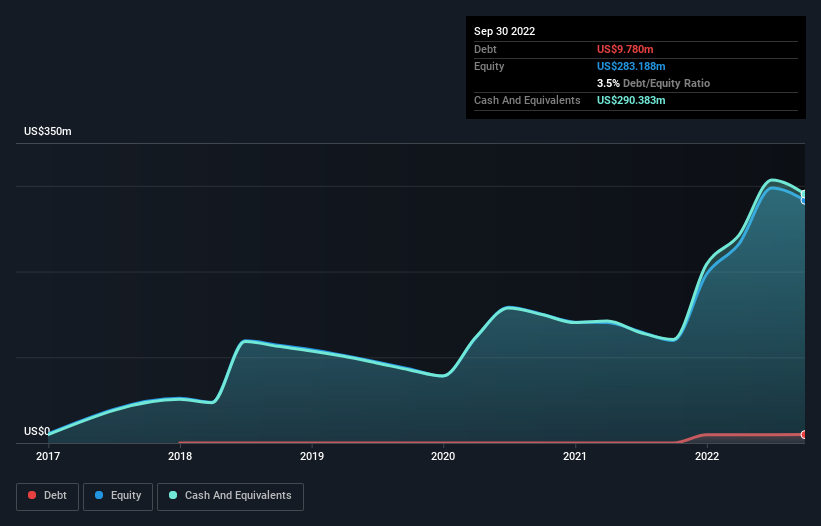
David Iben put it well when he said, 'Volatility is not a risk we care about. What we care about is avoiding the permanent loss of capital.' It's only natural to consider a company's balance sheet when you examine how risky it is, since debt is often involved when a business collapses. We can see that Kezar Life Sciences, Inc. (NASDAQ:KZR) does use debt in its business. But the more important question is: how much risk is that debt creating?
When Is Debt A Problem?
Debt assists a business until the business has trouble paying it off, either with new capital or with free cash flow. If things get really bad, the lenders can take control of the business. However, a more usual (but still expensive) situation is where a company must dilute shareholders at a cheap share price simply to get debt under control. Having said that, the most common situation is where a company manages its debt reasonably well - and to its own advantage. When we think about a company's use of debt, we first look at cash and debt together.
Check out the opportunities and risks within the US Biotechs industry.
What Is Kezar Life Sciences's Net Debt?
The image below, which you can click on for greater detail, shows that at September 2022 Kezar Life Sciences had debt of US$9.78m, up from none in one year. But it also has US$290.4m in cash to offset that, meaning it has US$280.6m net cash.

How Strong Is Kezar Life Sciences' Balance Sheet?
Zooming in on the latest balance sheet data, we can see that Kezar Life Sciences had liabilities of US$9.60m due within 12 months and liabilities of US$12.0m due beyond that. Offsetting this, it had US$290.4m in cash and US$70.0k in receivables that were due within 12 months. So it actually has US$268.9m more liquid assets than total liabilities.
This surplus liquidity suggests that Kezar Life Sciences' balance sheet could take a hit just as well as Homer Simpson's head can take a punch. With this in mind one could posit that its balance sheet means the company is able to handle some adversity. Simply put, the fact that Kezar Life Sciences has more cash than debt is arguably a good indication that it can manage its debt safely. When analysing debt levels, the balance sheet is the obvious place to start. But ultimately the future profitability of the business will decide if Kezar Life Sciences can strengthen its balance sheet over time. So if you're focused on the future you can check out this free report showing analyst profit forecasts.
Since Kezar Life Sciences doesn't have significant operating revenue, shareholders may be hoping it comes up with a great new product, before it runs out of money.
So How Risky Is Kezar Life Sciences?
By their very nature companies that are losing money are more risky than those with a long history of profitability. And in the last year Kezar Life Sciences had an earnings before interest and tax (EBIT) loss, truth be told. And over the same period it saw negative free cash outflow of US$56m and booked a US$64m accounting loss. But the saving grace is the US$280.6m on the balance sheet. That kitty means the company can keep spending for growth for at least two years, at current rates. Even though its balance sheet seems sufficiently liquid, debt always makes us a little nervous if a company doesn't produce free cash flow regularly. When analysing debt levels, the balance sheet is the obvious place to start. But ultimately, every company can contain risks that exist outside of the balance sheet. For example Kezar Life Sciences has 4 warning signs (and 2 which are a bit unpleasant) we think you should know about.
If you're interested in investing in businesses that can grow profits without the burden of debt, then check out this free list of growing businesses that have net cash on the balance sheet.
Valuation is complex, but we're here to simplify it.
Discover if Kezar Life Sciences might be undervalued or overvalued with our detailed analysis, featuring fair value estimates, potential risks, dividends, insider trades, and its financial condition.
Access Free AnalysisHave feedback on this article? Concerned about the content? Get in touch with us directly. Alternatively, email editorial-team (at) simplywallst.com.
This article by Simply Wall St is general in nature. We provide commentary based on historical data and analyst forecasts only using an unbiased methodology and our articles are not intended to be financial advice. It does not constitute a recommendation to buy or sell any stock, and does not take account of your objectives, or your financial situation. We aim to bring you long-term focused analysis driven by fundamental data. Note that our analysis may not factor in the latest price-sensitive company announcements or qualitative material. Simply Wall St has no position in any stocks mentioned.
About NasdaqCM:KZR
Kezar Life Sciences
A clinical-stage biotechnology company, engages in the discovery and development of novel small molecule therapeutics to treat unmet needs in immune-mediated diseases in the United States.
Excellent balance sheet slight.
Market Insights
Community Narratives



